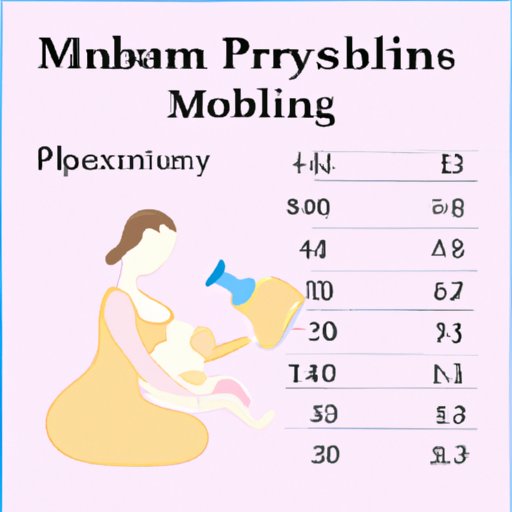
Introduction
Breastfeeding and pumping are two critical components of providing proper nutrition to your baby. However, combining breastfeeding and pumping can be a new and intimidating process for new mothers. Many mothers face difficulty managing breastfeeding and pumping, and while pumping offers the freedom for you to take a break or handle tasks, it can lead to many specific challenges. Therefore, in this article, we will provide a step-by-step guide to combine breastfeeding and pumping effectively and help you adjust to this lifestyle without any hassle.
A Step-by-Step Guide for Beginners
Combining breastfeeding and pumping is an effective way of ensuring that your baby gets proper milk supply and also helps you maintain a pumping schedule. First, it is vital to understand that breastfeeding and pumping have their perks. While breastfeeding provides nutrition and emotional bonding, pumping helps you save the milk for later use and offers convenience for tasks like working or running errands.
When beginning, you need to choose the right pump and set up the designated area for pumping with comfortable seating and good lighting. You can start with pumping sessions by selecting a specific time for pumping while breastfeeding or immediately after breastfeeding. It helps maintain a steady milk supply and also helps you watch the time for pumping.
How to Create a Pumping Schedule that Works for You
A pumping schedule can help you achieve an effective balance between breastfeeding and pumping. It helps in maintaining a steady milk supply, prevents discomfort, and makes pumping more efficient. The first step in creating a pumping schedule is to prioritize breastfeeding over pumping to maintain your supply. Try pumping before feeding your baby or right after feeding your baby. You can also pump early in the morning when your milk supply is high and pump once or twice a day, depending on your breastfeeding schedule. Pumping less or more than necessary can create too little or too much milk, which may lead to discomfort or affect the milk supply.
Breastfeeding and Pumping in the Workplace
Returning to work while breastfeeding can be challenging, but it is very doable. You may face the challenge of finding a private space to pump and arrange your pumping schedules with your employer. Therefore, it is essential to communicate with your employer about regular pumping breaks and the duration of each session. Investing in a good breast pump and bringing all necessary supplies like pumping bras and milk storage containers can make pumping more efficient.
Getting the Most Out of Your Pumping Sessions
Several factors influence the effectiveness of a pumping session, including relaxation, comfort, and massage. Warming up your breasts before pumping can help improve your milk flow. Applying heat pads to your breasts, massaging your nipples, and leaning forward toward the pump can stimulate milk production. You can also enhance the experience by creating a relaxed environment with good lighting, comfortable chairs, and playing soothing music. Using a hands-free pumping bra to avoid holding the flanges and freeing your hands to handle other tasks can make pumping rather comfortable and efficient.
Combining Breastfeeding with Exclusive Pumping
Exclusive pumping is a way of producing milk without breastfeeding. Combining breastfeeding and exclusive pumping is an acceptable lifestyle if you need or want to maintain milk supply. You can supplement breastfeeding sessions, which offer emotional bonding, with pumping, which can offer freedom and convenience.
You can achieve exclusiveness by replacing one or two breastfeeding sessions per day with pumping sessions or by nursing your baby after pumping sessions. Using a supplemental nursing system, which is attached to the bottle, is a method that helps the baby get more milk while still breastfeeding. It can also help stimulate the milk supply and create an emotional bond while pumping.
Tips for Overcoming Challenges
Combining breastfeeding and pumping can have its challenges, and every mother may experience different experiences. Such difficulties may include breastfeeding pains, clogged milk ducts, and low milk supply. When facing breastfeeding or pumping challenges, seeking support from healthcare professionals or lactation consultants can help. Healthcare professionals can offer guidance concerning your overall health while lactation consultants can help identify specific challenges you face. Also, drinking plenty of fluids, massaging breasts, and taking enough rest can help relieve conditions that affect milk supply.
Real-life Stories from Breastfeeding Moms
Reading real-life experiences from other mothers can offer insight and inspiration. Breastfeeding is a lifestyle unique to every mother, and therefore, it is vital to hear and share their experiences of combining breastfeeding and pumping. Their experiences can offer insight, inspiration, and comfort.
Conclusion
Combining breastfeeding and pumping is a choice that can work well for mothers and their babies. Nevertheless, it takes patience, determination, and proper guidance to adjust to the new lifestyle. Creating a pumping schedule that works well for you, pumping more efficiently, and seeking support when faced with challenges are essential elements in this lifestyle. Even though every mother may face unique situations, the key takeaway is to find a suitable routine that works best for their baby, and in case of difficulties, seek guidance from healthcare professionals, friends, or family.




